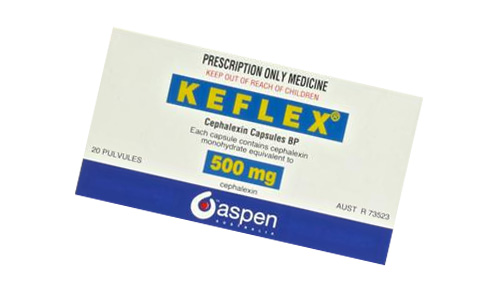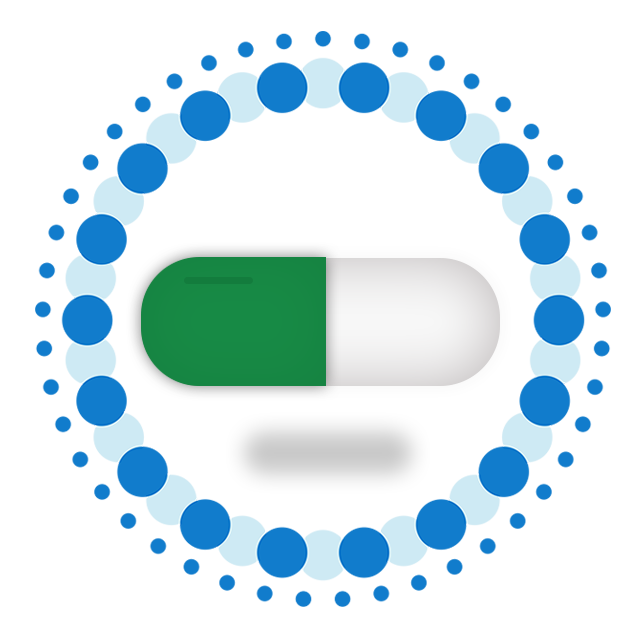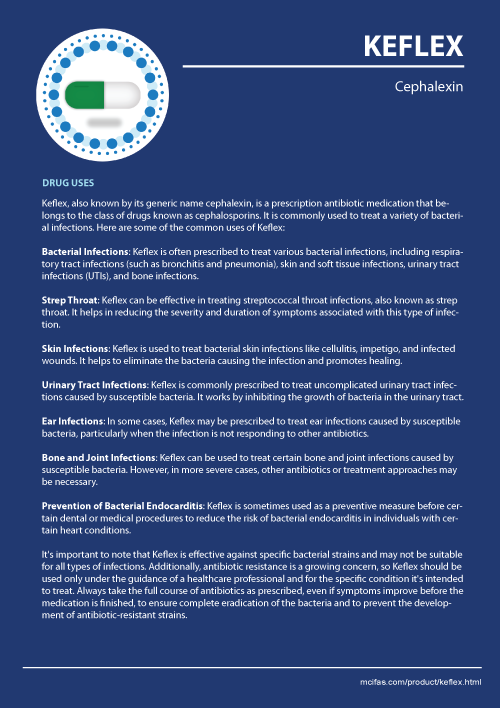Keflex Prescribing Information
Bacterial infections can prove to be severe in recent days if not treated with proper attention and care. There are possibilities of the infections to spread to the other parts of the body if not attended with care. Therefore the use and the consumption of the antibiotics has to be enforced by the doctors and the physicians to counter the growing problem of bacterial infections. There are many anti-bacterial medicines and drugs that are available in the market. Keflex is a very effective antibiotic medicine that helps the body to fight the growing infections and cure the infected parts of the body rapidly.
Keflex consists of the key ingredient known as cephalexin that helps to fight the different bacterial infections. Cephalexin belongs to the category of the cephalosporin that very useful in fighting the different skin infections. Antibiotic also helps to fight bacterial growth in the ear and the urinary tracts. The medicine is also recommended by the different dentists after any surgery as this drug helps to prevent and fight the germs and the bacterial infections that might develop in the place of the surgery. The medicine should be prescribed only after considering the historical and the present health conditions of the patient. It is advised not to consume the medicine if the patient is suffering from severe heart conditions or if the patient has undergone any heart surgeries as well.

Uses of Keflex
Here are some of the common uses:
- Bacterial Infections: Keflex is often prescribed to treat various bacterial infections, including respiratory tract infections (such as bronchitis and pneumonia), skin and soft tissue infections, urinary tract infections (UTIs), and bone infections.
- Strep Throat: Medicine can be effective in treating streptococcal throat infections, also known as strep throat. It helps in reducing the severity and duration of symptoms associated with this type of infection.
- Skin Infections: Antibiotic is used to treat bacterial skin infections like cellulitis, impetigo, and infected wounds. It helps to eliminate the bacteria causing the infection and promotes healing.
- Urinary Tract Infections: Remedy is commonly prescribed to treat uncomplicated urinary tract infections caused by susceptible bacteria. It works by inhibiting the growth of bacteria in the urinary tract.
- Ear Infections: In some cases, Drug may be prescribed to treat ear infections caused by susceptible bacteria, particularly when the infection is not responding to other antibiotics.
- Bone and Joint Infections: Keflex can be used to treat certain bone and joint infections caused by susceptible bacteria. However, in more severe cases, other antibiotics or treatment approaches may be necessary.
- Prevention of Bacterial Endocarditis: Keflex is sometimes used as a preventive measure before certain dental or medical procedures to reduce the risk of bacterial endocarditis in individuals with certain heart conditions.
Dosage
The dosage of Keflex can vary depending on the type of infection being treated, the severity of the infection, the patient's age, weight, and overall health, as well as the specific recommendations of the prescribing healthcare provider. It's important to follow your doctor's instructions and the information provided on the medication label. The following dosage information is a general guideline and may not apply to all situations. Always consult your healthcare professional for personalized dosing instructions.
Typical Dosages for Adults:
Bacterial Infections:
- The usual adult dose for most infections is 250 mg every 6 hours or 500 mg every 12 hours.
- For more severe infections, the dosage may be increased to 500 mg every 6 hours or 1 gram every 12 hours.
Strep Throat:
- The typical dosage for treating streptococcal throat infections is 500 mg every 12 hours for 10 days.
Skin and Soft Tissue Infections:
- The usual adult dose for skin and soft tissue infections is 250 mg every 6 hours or 500 mg every 12 hours.
Urinary Tract Infections:
- The typical dosage for uncomplicated urinary tract infections is 250 mg every 6 hours or 500 mg every 12 hours.
Bone and Joint Infections:
- The dosage for bone and joint infections can vary widely and should be determined by the treating healthcare provider based on the specific situation.
Dosages for Pediatric Patients:
- The dosages for children are generally based on their body weight. Pediatric dosages can vary greatly and should be determined by a healthcare provider.
It's important to take Keflex as directed and for the full course of treatment, even if symptoms improve before the medication is finished. This helps ensure that the infection is completely eradicated and reduces the risk of antibiotic resistance.
Side Effects of Keflex
Keflex is generally considered safe and well-tolerated when used as prescribed. However, like any medication, it can cause side effects in some individuals. Not everyone will experience these side effects, and they can vary in terms of frequency and severity. Common and less severe side effects may include:
Gastrointestinal Distress:
- Nausea
- Vomiting
- Diarrhea
- Abdominal pain or discomfort
Skin Reactions:
- Rash
- Itching
- Allergic reactions
Oral and Vaginal Candidiasis:
- Oral thrush (white patches in the mouth)
- Vaginal yeast infection
Headache
Dizziness
Fatigue
Joint Pain
Mild Blood Disorders:
- Some people may experience mild changes in blood cell counts.
It's important to be aware of the possibility of more serious side effects that could require medical attention. While rare, these can include:
Severe Allergic Reactions (Anaphylaxis):
- Symptoms may include difficulty breathing, swelling of the face/throat/tongue, severe rash, and rapid heartbeat. Anaphylaxis is a medical emergency and requires immediate attention.
Severe Skin Reactions:
- Conditions like Stevens-Johnson syndrome or toxic epidermal necrolysis can cause widespread rash, blistering, and peeling of the skin. These are rare but serious reactions.
Pseudomembranous Colitis:
- This is an inflammation of the colon often associated with antibiotic use. It can cause severe diarrhea, abdominal pain, and potentially life-threatening complications.
Hepatitis (Liver Inflammation):
- Symptoms may include jaundice (yellowing of the skin and eyes), dark urine, and abdominal pain.
Kidney Problems:
- Although rare, some people might experience changes in kidney function.
Interaction with other drugs
Keflex can interact with other drugs, potentially affecting their effectiveness or causing adverse effects. It's important to inform your healthcare provider about all medications, supplements, and herbal products you are taking before starting Keflex. Here are some examples of drug interactions to be aware of:
Probenecid:
Probenecid is used to treat gout and can increase the levels of Keflex in the body. This might lead to an increased risk of side effects.
Metformin:
- Medicine could potentially affect blood sugar levels and interfere with the effectiveness of metformin, a medication used to treat diabetes. Close monitoring of blood sugar levels is advisable if these medications are taken together.
Blood Thinners (Anticoagulants):
- Keflex might have an effect on blood clotting, which could potentially interact with blood-thinning medications like warfarin. Close monitoring of blood clotting parameters is important if these medications are used together.
Oral Contraceptives:
- There is a theoretical risk that Cephalexin could reduce the effectiveness of hormonal contraceptives (birth control pills). Additional contraception methods might be recommended during Keflex treatment.
Proton Pump Inhibitors (PPIs) and Antacids:
- Medications like PPIs and antacids used to reduce stomach acid might affect the absorption of Keflex. It's generally recommended to take tablets at least an hour before or two hours after these medications.
Methotrexate:
- Methotrexate, a medication used to treat certain conditions like rheumatoid arthritis and certain cancers, can interact with Keflex. Cephalexin might increase the levels of methotrexate in the body, potentially leading to toxicity.
Vitamin K:
- Keflex can potentially interfere with vitamin K metabolism, which could affect blood clotting. If you are taking vitamin K supplements or foods rich in vitamin K, discuss this with your healthcare provider.
Other Antibiotics:
- There might be interactions between Keflex and other antibiotics, so it's important to let your healthcare provider know if you are taking any other antibiotics concurrently.
What to avoid while on Keflex
While taking Keflex, there are certain things you should avoid to ensure the effectiveness and safety of the medication. Here are some important considerations:
Alcohol:
- While there is no specific interaction between Keflex and alcohol, it's generally recommended to avoid excessive alcohol consumption when taking antibiotics. Alcohol can affect your body's immune response and may also potentially worsen side effects like gastrointestinal upset.
Antacids and Calcium Supplements:
- Avoid taking antacids or calcium supplements within a couple of hours of taking Keflex. These can interfere with the absorption of the antibiotic and reduce its effectiveness.
Iron Supplements:
- Similar to antacids, iron supplements can reduce the absorption of Cephalexin. If you need to take iron supplements, it's advisable to separate the timing of your iron dose from your Keflex dose.
Vitamin K Supplements:
- Cephalexin has the potential to affect vitamin K metabolism, which plays a role in blood clotting. While the interaction is not fully understood, it's a good idea to avoid high-dose vitamin K supplements while on Keflex.
Hormonal Birth Control:
- Keflex might reduce the effectiveness of hormonal birth control methods, such as birth control pills. If you rely on hormonal contraception, consider using additional contraceptive methods while taking Keflex and for some time after completing the course.
Activities Requiring Alertness:
- While Keflex is not known to cause significant drowsiness or impairment, some individuals might experience side effects that affect alertness or coordination. If you experience any such effects, avoid activities like driving or operating heavy machinery until you know how the medication affects you.
High-Fiber Foods:
- High-fiber foods might delay the absorption of Keflex. While this interaction is not usually clinically significant, you might consider adjusting your diet if you find that high-fiber foods are affecting the timing of your medication.
Other Antibiotics:
- If you are on multiple antibiotics, it's important to follow your healthcare provider's instructions regarding timing and dosing. Certain antibiotics can interact with each other.
Contraindications of Keflex
Contraindications are specific medical conditions, circumstances, or factors that make the use of a particular medication, in this case, Keflex, potentially dangerous or inappropriate. If a person has a contraindication to a medication, it means that using that medication could pose significant risks to their health. Here are some contraindications for Keflex:
Allergic Reaction to Cephalosporins or Penicillins:
- If an individual has a known severe allergic reaction (anaphylaxis) to cephalosporin antibiotics (including Keflex) or penicillins, using Keflex is contraindicated. Cross-reactivity between these antibiotic classes can occur, leading to potentially life-threatening reactions.
Previous Severe Allergic Reactions to Keflex:
- If someone has previously experienced a severe allergic reaction to Keflex, it's contraindicated to use the medication again.
History of Severe Gastrointestinal Disease, Especially Colitis:
- Keflex can disrupt the balance of bacteria in the gut and potentially lead to overgrowth of harmful bacteria, causing a condition called pseudomembranous colitis. People with a history of severe gastrointestinal disease or colitis should be cautious with Keflex.
Kidney Disease:
- Cephalexin is primarily eliminated from the body through the kidneys. Individuals with severe kidney impairment may need adjusted dosages or should avoid Keflex altogether.
Porphyria:
- Porphyria is a group of rare genetic disorders that affect the nervous system and skin. Certain antibiotics, including Keflex, can potentially trigger or exacerbate symptoms of porphyria.
Certain Medical Conditions:
- Some medical conditions, such as a history of seizures or epilepsy, may require caution when using Keflex. Discuss any underlying medical conditions with your healthcare provider before starting this medication.
Certain Medications:
- Some medications can interact with Cephalexin or increase the risk of certain side effects. For example, probenecid can affect the elimination of Keflex from the body and may lead to increased levels of the antibiotic.
Pregnancy and Keflex
Antibiotic is generally considered safe to use during pregnancy when prescribed by a healthcare provider. However, as with any medication, it's important to weigh the potential benefits against the potential risks. Here's what you need to know about pregnancy and Keflex:
Category B Pregnancy Classification:
- Keflex is classified as a Category B medication by the U.S. Food and Drug Administration (FDA) for pregnancy. This means that animal studies have not shown any harmful effects on the fetus, and there are no well-controlled studies in pregnant women to confirm its safety. While animal studies can provide some reassurance, the use of Keflex in pregnant women is generally considered acceptable when the potential benefits outweigh the risks.
Considerations for Use:
- When considering the use of Cephalexin during pregnancy, healthcare providers will take several factors into account, including the severity of the infection being treated and the overall health of the mother. If the infection poses a significant risk to the mother or if left untreated could harm the developing fetus, the benefits of treating the infection with Keflex may outweigh any potential risks.
Precautions:
- As a precaution, pregnant individuals should inform their healthcare provider about their pregnancy status before starting any medication, including Cephalexin. The healthcare provider will assess the specific situation and determine the most appropriate treatment plan.
Timing and Dosage:
- The timing and dosage of Keflex during pregnancy will be determined by the healthcare provider. Generally, antibiotics like Keflex are used in the lowest effective dose and for the shortest duration necessary to treat the infection.
Breastfeeding:
- Medicine is excreted in breast milk in small amounts. While it is generally considered safe for breastfeeding mothers, it's important to discuss its use with your healthcare provider. They can help assess the potential risks and benefits and provide guidance on whether it's appropriate to continue breastfeeding while taking Keflex.
» Drug Uses (format pdf, 0.2 Mb)



